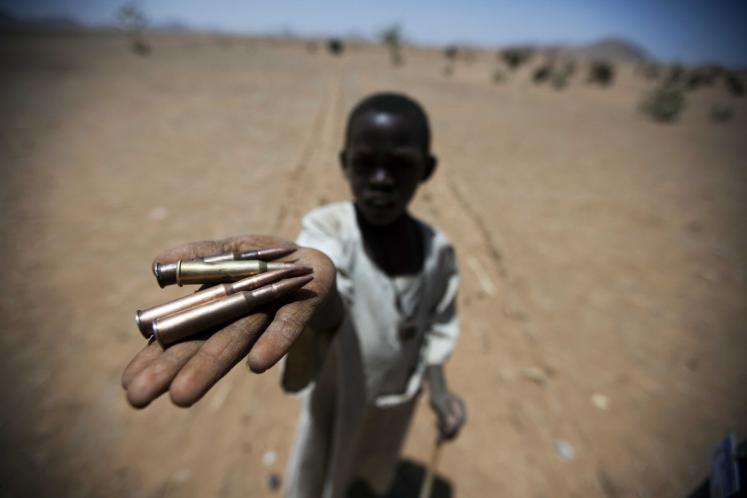In August 2014, UN Special Representative of the Secretary-General (SRSG) for Children and Armed Conflict Leila Zerrougui visited the Serendi Rehabilitation Centre in Mogadishu, Somalia, a facility for the disarmament, demobilization, and reintegration (DDR) of al Shabaab defectors. After her visit, the SRSG raised concerns about the treatment of children at Serendi, where they were detained alongside adults; not charged with any crime, but denied representation and access to the criminal justice system; and unable to visit their families,1 in apparent violation of international standards, human rights law, and the Convention on the Rights of the Child.2
The Somali Federal Government (SFG) initially resisted any demands to release the children into the custody of a UN agency or other entity, citing violent acts committed by some of the children and a continued threat posed by others. Following the SRSG's criticism of Serendi, other DDR camps in the country refused to admit children, leaving children who wanted to defect with few safe options. Last month, however, after negotiations that lasted over a year, the SFG approved the release of 64 children from Serendi to UNICEF and a local implementing partner.3 This development – while likely improving the wellbeing of the children involved – does not necessarily represent a broader shift in the country’s policy for handling children associated with violent extremism. Yet such a policy shift may be warranted as the government’s current approach may prove problematic not only from a human rights standpoint, but also from a national security perspective. Indeed, there is some evidence that employing repressive counter-terrorism policies can exacerbate conflict and fuel extremism in the long term.4 Likewise, providing ineffective disengagement and reintegration programming or denying access to children altogether may have equally counter-productive outcomes for national security.5 Given that the underlying dynamics at play and the recruitment of children into violent extremist groups are not unique to Somalia, this example raises important questions with broad significance on how to address children associated with violent extremism in conflict scenarios and beyond.
In Somalia, like in some other conflict contexts, the SFG’s approach to children associated with violent extremists grew out of two dynamics: (1) a lack of state capacity, and (2) a divergence in perspectives about the conflict and responses it necessitates among actors on the ground, including the SFG, AU/AMISOM, UN entities, international and local NGOs, and other Member States.
To the first point, Somalia, like most states locked in civil conflict, lacks the infrastructure, expertise, and resources to effectively disengage and reintegrate many of those who end up in DDR camps. This is especially true with regard to meeting the expectations laid out by the UN’s Integrated Disarmament, Demobilization, and Reintegration Standards (IDDRS), a policy guidance document, for the treatment of children.6 DDR programmes in these contexts frequently fail to meet child-specific standards, operating more as detention systems for an array of criminals, captured insurgents, and others swept up in counter-insurgency operations, including minors.7 Such an approach undermines the effectiveness of DDR efforts for children, as these conditions can make it harder to successfully disengage them from the adult commanders with whom they are housed. Worse yet, the collocation of children with extremist insurgents, captured on the battlefield with no intention of disengaging from violence, could have a radicalizing impact on, or threaten the lives of, those children trying to disengage from al Shabaab.
To the second point, the Somali government, in the midst of a full-blown counter-insurgency / counter-terrorism campaign against al Shabaab for the survival of the state, often views DDR as an extension of that campaign.8 Thus children in DDR tend to be viewed as security threats rather than victims,9 a perspective that is often used to justify harsh counter-terrorism-oriented responses (e.g. unwarranted detention, extrajudicial punishment) rather than child-oriented DDR programming for children in violent extremist contexts. Such a perspective rejects the very premise upon which much of the international community operates – that minors are incapable of informed consent and therefore, even if they are members of a recognized terrorist group, must be viewed primarily as victims and dealt with as such. The international community has repeatedly decried the mistreatment of children in such contexts, demanding adherence to international human rights law and DDR standards. Such demands, however, often fall on deaf ears as host state officials feel they ignore legitimate security concerns. The international community, which tends to be both fragmented and programmatically disjointed in its approach to child protection, has only limited leverage over host states. This divergence of perspectives is problematic, both because it fails to capture the nuance of such situations, and it leads to tension between partners who are ultimately unified toward the same broad goals. While the majority of the children involved with al Shabaab are victims – they had little choice but to engage with the group in some way (e.g. as a scout, cook, or even by just living in Shabaab controlled territory) – there are exceptions. There are child combatants who hold extremist views and are determined to use violence to further them, and these children do represent a legitimate security concern to the state.
International pressure on states to adhere to UN DDR standards and international human rights law, however well-intentioned, can also have the counter-productive effect of incentivizing states to deny children access to DDR programmes altogether.10 In conflict zones, the denial of services can have deadly outcomes for children involved with violent extremist groups as they have fewer safe options for defection,11 and also for society, as an extremist group that maintains its ranks will likely remain a security threat.
Thoughtful, child-sensitive, and principled approaches to disengaging children associated with violent extremist groups are important for improving both human rights and security in conflict-affected countries. There are three relatively modest reforms that could drastically help improve international responses to children in contexts affected by violent extremism.
First, international actors working in this area must acknowledge that in some cases host states may have valid security concerns regarding the potential threats posed by violent extremist children to the community. Refusal to acknowledge the validity of all such concerns, and instead demanding adherence to the IDDRS, can result in exacerbated tensions with the state, diminished transparency and access to children held in DDR camps, and, ultimately, worse treatment outcomes for children across the board. To avoid this, international actors and states must come together to find principled, yet practical, compromises that address security threats while creating the best conditions for children in violent extremist contexts.
Second, different UN actors should adopt cross-programmatic guidance on how to deal with children in violent extremist contexts and work with implementing partners, donors, and NGOs to establish greater cohesion in their approach. Improved coordination would allow the international community to speak with one voice and enhance its leverage with host states.
Lastly, these programmatic approaches must be grounded in empirical evidence and sound theories of change. For those children who have access to DDR services, some have been required to participate in deradicalization programmes, even when the latter may be inappropriate (e.g. because the child’s only association was to live in a town controlled by al Shabaab) or could do more harm than good. To craft more effective interventions requires more research on the unique processes of child disengagement from violent extremist groups in a variety of contexts. Such research would benefit not only those actors operating in conflict contexts, but also those states who are seeking to stem the flow of child foreign fighters and improve their long-term security.
[1] “Somali child soldiers ‘punished’ in foreign-funded camps: UN,” Yahoo News/AFP, 21 August 2014, and Office of the Special Representative of the Secretary-General for Children and Armed Conflict, “UN Special Representative for Children and Armed Conflict Calls for Full Implementation of Action Plans by Federal Government of Somalia,” 22 August 2014, available from https://childrenandarmedconflict.un.org/press-release/special-representative-calls-for-full-implementation-action-plans-somalia/ (accessed on 20 October 2015).
[2] Somalia ratified the Convention on the Rights of the Child in January 2015. See UNICEF, “Joint statement on Somalia’s ratification of the Convention on the Rights of the Child,” Press Statement, available from https://childrenandarmedconflict.un.org/2015/10/joint-statement-on-somalias-ratification-of-the-convention-on-the-rights-of-the-child/ (accessed on 27 October 2015).
[3] According to sources familiar with the release, 33 were returned to their families, but will attend day programming aimed at socioeconomic reintegration. The remaining 31 children will receive similar services while housed in an interim care facility, away from their families.
[4] For research that concludes that hard-line counter-terrorism policies are generally ineffective, see, for example, Seth G. Jones and Martin C. Libicki, How Terrorist Groups End: Lessons for Countering al Qa’ida, (Santa Monica: RAND, 2008); and Walter Enders and Todd Sandler, “The Effectiveness of Antiterrorism Policies: A Vector –Autoregression-Intervention Analysis,” American Political Science Review, Vol. 87, No. 4., (December 1993). For examples of research that argues that hard-line antiterrorism policies can actually exacerbate violent extremism, Robert White, “From Peaceful Protest to Guerrilla War: Micromobilization of the Provisional Irish Republican Army,” American Journal of Sociology, Vol. 94, No. 6 (May, 1989); and Laura Dugan and Erica Chenoweth, “Moving Beyond Deterrence: The Effectiveness of Raising the Expected Utility of Abstaining from Terrorism in Israel,” American Sociological Review, Vol. 77, No. 4 (2012).
[5] The DRC is cited as an example of an under-resourced, inadequate DDR program for children, which was unable to accommodate the thousands of children demobilized there, and which coincided with a sharp increase in the use of children by armed groups. See Child Soldiers International, “Briefing on the recruitment and use of children in the Democratic Republic of the Congo (DRC) to the UN Security Council Working Group on Children and Armed Conflict,” 31 July 2014.
[6] The IDDRS specifies that children should be separated from adults, provided tailored programming, and reunited with their families when appropriate. United Nations, Operational Guide to the Integrated Disarmament, Demobilization, and Reintegration Standards, 2014.
[7] Given the intrastate nature of the conflict in Somalia, and in many other civil wars, those captured in battle are not afforded a POW status. Their treatment poses difficult legal questions, especially for international forces assisting host states to put down insurgencies.
[8] Vanda Felbab-Brown, “DDR in the Context of Offensive Military Operations, Counterterrorism, CVE and Non-Permissive Environments” and “A Bridge Not Too Far: A Field Report from Somalia,” in James Cockayne and Siobhan O’Neil, eds., UN DDR in an Era of Violent Extremism: Is it Fit for Purpose? (New York: UN University, 2015), p. 43 and p. 117, respectively.
[9] Indeed, UNU’s recent research on DDR in Somalia demonstrated that the Somali intelligence services view DDR participants – including children - as potential security threats, and, not surprisingly, there have been allegations that participants have been tortured to gain intelligence; recruited as spies or soldiers and sent back to the battlefield; or subjected to extrajudicial justice. See Felbab-Brown, “A Bridge Not Too Far.”
[10] For example, in Somalia, following international criticism of the treatment of children in Serendi, no other children appeared to have been admitted to that facility, nor were they admitted to Baidoa DDR camp. Felbab-Brown, “A Bridge Not Too Far,” p. 128.
[11] In an analogous situation, women were denied resident status at the Baidoa DDR camp because of the lack of separate facilities, in several cases, they – and their families’ - residences subsequently came under attack by al Shabaab. Ibid., p. 126, footnotes 218 and 219.
Suggested citation: O’Neil Siobhan., "Disengaging Children in Violent Extremist Contexts," UNU-CPR (blog), 2015-10-29, https://unu.edu/cpr/blog-post/disengaging-children-violent-extremist-contexts.


